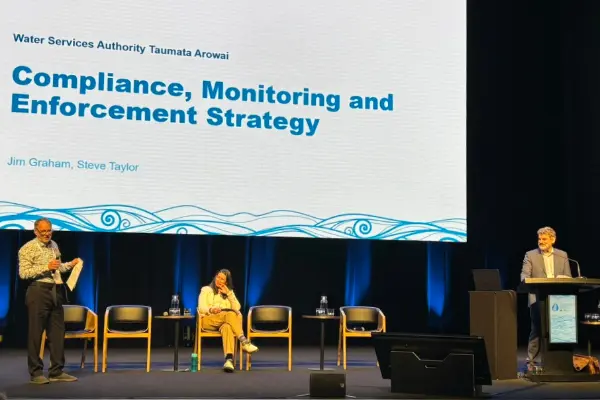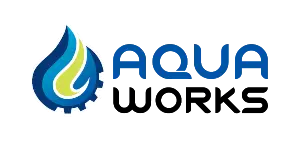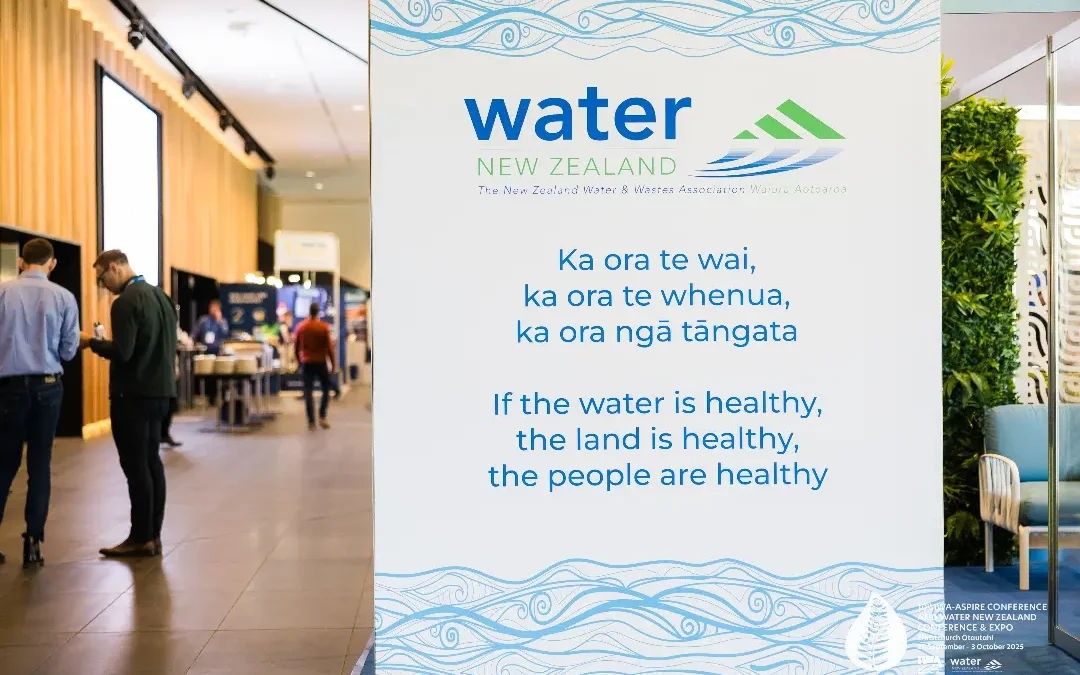Steve here — founder and CEO at Aqua Works in Warkworth. I’ve just come back from the Water New Zealand Conference & Expo 2025 in Christchurch, the biggest gathering on the water industry’s calendar. It ran from 29 September to 3 October and also included the IWA conference. IWA is the International Water Association, and their annual conference was held alongside ours, so there were many international speakers on stage as well as our own locals.
The energy was electric: engineers, suppliers, regulators, iwi partners, and innovators all in one place. 5 day of talking about how we deliver safer water for every community, large and very small, including ours in Rodney.
What this article covers at a glance
💧 The significant regulatory shifts every small or very small drinking-water supplier needs to know. This includes the new registration and compliance dates and what still applies for new supplies.
💧 What changed in September 2025 with Taumata Arowai’s updated Acceptable Solutions. Why that’s good news for small suppliers using UV and cartridge filtration.
💧 How this lands in Rodney/Warkworth for rural tanks, bores, and small schemes. Plus a simple action plan you can follow now.
💧Aqua Works’ role in helping local suppliers map a compliant, cost-sensible pathway (design, install, maintain, document).
💧FAQ to answer the questions we’re hearing most since Christchurch.
From conference buzz to boots on the ground: what actually changes for you
There was plenty of big-picture talk — AI, assets, climate resilience — but the most practical takeaway for our customers is this: Taumata Arowai has clarified the timelines and simplified the compliance pathways for small supplies—less ambiguity, more doable.
Here’s how that lands on your site.
The headline, unpacked — dates, duties, and “day one”
1) If you run an unregistered drinking-water supply:
You now have until November 2028 to register with Taumata Arowai. That’s a firm date — and it gives small suppliers time to plan upgrades, budget sensibly, and avoid a last-minute scramble.
2) Meeting your legal responsibilities:
Once registered, you must meet the full legal responsibilities by November 2030. Note that the fundamental duty to supply safe drinking water applies right now; the 2030 date is about meeting all the specific obligations.
3) Starting something new? “From day one” still stands:
If you’ve established a supply any time since 15 November 2021, you must register and meet all relevant responsibilities from the time it’s set up. There’s no grace period for new supplies — the extension applies only to unregistered legacy supplies.
Why is this great news for small suppliers
In September 2025, Taumata Arowai updated the Acceptable Solutions to make compliance simpler, more transparent and more cost-effective for smaller suppliers. There are now three streamlined pathways covering common scenarios:
➤ Mixed-use Rural,
➤ Small to Medium Networks (up to 500 people), and
➤ Self-supplied Buildings (up to 500 people, up to 10 buildings under common ownership).

These are legal instruments (secondary legislation) that act like a pre-approved recipe. For many rural properties, lifestyle blocks, and small community schemes, compliance can be achieved with end-point treatment using a 5-micron cartridge filter and UV (≥40 mJ/cm²), provided the system is correctly sized, validated (where required), maintained and documented.
What this means in practice in Rodney/Warkworth
If your supply serves ≤500 people and fits one of the scenarios above, you can likely follow Taumata Arowai Acceptable Solutions 2025 rather than develop a complete Drinking Water Safety Plan under the Rules. That cuts paperwork and removes guesswork — especially for the UV + filtration systems we have installed and looked after locally for more than 20 years.
What I heard (and asked) in Christchurch
Between keynotes and the expo floor, I spent a good chunk of time with Taumata Arowai staff walking through “how this lands” on the ground. Three takeaways stood out:
- Maintenance isn’t box-ticking; it’s risk control. The updated guidance doubles down on scheduled maintenance, performance checks and record-keeping as the backbone of safety — not paperwork for paperwork’s sake. (If the lamp hours on your UV aren’t tracked and validated, you’re flying blind.)
- Simple, defined pathways beat bespoke everything. When a supply fits an Acceptable Solution, you get a pre-approved recipe: source protection → treatment → verification → monitoring → reporting. Less ambiguity, fewer surprises.
- Early mapping saves late panic. With dates now fixed (register by Nov 2028, full responsibilities by Nov 2030), suppliers who map their pathway this year avoid the last-minute scramble — and spread costs sensibly over time.
What this means if you’re on rural, rainwater, bore or small schemes
If your property or site supplies water beyond a single-family home — e.g., a workplace with staff/contractors, a café or cellar door, a farm enterprise, accommodation, or a small community scheme — you’re a drinking water supplier and will need to be registered with Taumata Arowai by November 2028, then meet the full legal responsibilities by November 2030. From there, pick the right pathway: an Acceptable Solution (simplest if you fit) or a tailored compliance plan under the Rules.
Bottom line: compliance doesn’t have to be complicated or costly — but it does have to be deliberate. Choose the right treatment solution, maintain it well, and keep good records.
Our practical checklist and what we’ll do with you
- Confirm your supplier status and whether an Acceptable Solution fits (roof water, bore/spring, or mixed-use rural).
- Audit your current system against the updated requirements — especially source protection, UV performance (dose, lamp life, sensor verification), and cartridge filtration configuration (micron rating, pressure differential, change-out frequency).
- Map the registration + compliance timeline to your site (with milestones through 2026–2030 so there’s no crunch in 2028/2030).
- Implement and document standard operating procedures, maintenance schedules, monitoring logs, and incident response procedures.
We’ve been building and maintaining these systems locally for 20+ years — and the new guidance aligns neatly with how we already design for reliability.
At Aqua Works, we design, install, service, and documentsmall drinking-water systemsacross Rodney — from UV and cartridge filtration for rural tanks and bores to water pumps, tanks, and plumbing, plus compliance support for small businesses, schools, and community facilities. We operate out of Warkworth, with on-call support and a fleet that covers Waipū to Auckland.
We also run a structured UV service programme (including annual reminders, lamp/sleeve changes, WOF-style checklists, and safe lamp disposal). Hence, your UV system actually delivers the dose it says on the tin — all year, every year.
Call Aqua Works — and avoid the 2028/2030 bottleneck
Not sure how the changes land for your site? Let’s talk through it, no fuss.
Book a free on-site assessment, and we will:
-
- confirm your supplier pathway (Taumata Arowai Acceptable Solution 2025 vs. Rules),
- test/source-check and size/validate your UV and filtration,
- build a phased plan to register in time and meet 2030 responsibilities, and
- set up maintenance & records that keep you compliant without hassle.
Call 0800 278 288 or 09 425 6080 to schedule your visit, or drop into 2 Mill Lane, Warkworth. Prefer mobile? 021 278 7427 also reaches us.
We’ll translate the rules into a practical system that delivers water you can trust — for life.
Frequently Asked Questions – Rain Tank Water Meter
💧 Do I really need to register my small supply in Rodney if it serves only a few buildings?
If it’s beyond a single private household and supplies people at work, customers, or a community/public facility, yes — you must register by November 2028 and meet full responsibilities by November 2030. (New supplies from 15 Nov 2021 must register and comply from establishment.) We can confirm your status in one site visit.
💧What’s the simplest compliance path for a café, winery, farm shed, or school around Warkworth?
Check if you fit an Acceptable Solution: Self-supplied Buildings (up to 500 people), Small to Medium Networks (up to 500), or Mixed-use Rural. If you do, you follow a clear, pre-approved recipe using 5-micron filtration + UV at the point of use.
💧Does my UV system need to be “validated”?
If yo ur treatment serves 25+ people or the public/community (e.g., school, marae, café), the UV must be validated and deliver ≥40 mJ/cm², with flow limited to spec. We’ll size, install, and document that for you.
💧We’re on rainwater — is end-point treatment enough?
Often yes, but the source has to be suitable (good UVT/turbidity, protected tanks, vermin/birds excluded). Some sources need pre-treatment. We’ll test first, then design accordingly.
💧 What maintenance proves compliance in the Rodney District?
Keep scheduled UV lamp/sleeve changes, filter change-outs, dose/flow checks, and records (we set these up for you). That maintenance is central to risk control — and it’s what inspectors look for.
💧 Can I do all this DIY and meet the legal requirements?
Yes – However, you will need a good understanding of all the legislation, you will need to register the supply and then engage a Certified Plumber such as Aqua Works to supply and install the system that you have decided on, once you have worked out the pathway of an Acceptable Solution or the Assurance rules.
Alternatively, Aqua Works offers a one-stop shop and can provide the complete service—understanding your needs, understanding the legal requirements, designing a system to deliver the most cost-effective solution that offers the best-quality water, installation, documentation, training, and service contracts.
Aqua Works is here to help you through this transition, whether you have a simple question or need help with the whole thing. Give us a call 0212 787 427.

